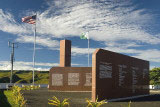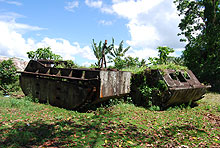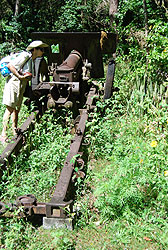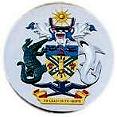GUADALCANAL.com
The Island of Guadalcanal in World War II

GUADALCANAL.comThe Island of Guadalcanal in World War II |
 |
|
|
|
|
|
The first major offensive launched by the Allies against Japan in World
War II took place on Guadalcanal from August 7, 1942, to February 9,
1943. Since the attack on Pearl Harbor on December 7, 1941, the Japanese
had advanced toward the South Pacific, threatening the Allies' South
Pacific ferry route connecting Australia and the United States.
In May and June, 1942, the U.S. Navy made headway against the Japanese advance in the Battles of the Coral Sea and Midway. These successes led the U.S. military to pursue a two-pronged assault in the Solomon Islands and New Guinea.
Guadalcanal, in the Solomon Islands, invaded by the Japanese in July, 1942, was one of the most important Japanese strongholds due to its proximity to Australia. The Japanese built an airfield at Lunga Point and artillery positions in the hills nearby and had about 8,400 men on the island by August.
On August 7, 1942, U.S. Marines landed on the northern beaches of Guadalcanal after Navy ships fired onto the island ahead of them. Over the next three months, the Marines secured the airfield and a 6 mile wide section of the beach.
On October 13, an Army unit arrived to reinforce the Marines. The Marines and Army soldiers repelled a Japanese attack on the 23rd, inflicting heavy losses on the Japanese and pushing the Japanese out further during the rest of the month.
On November 4th, the U.S. Infantry fought 1,500 Japanese troops that
landed on the beach at Koli Point. They killed half the Japanese force.
The rest escaped into the jungle.
In mid-November, the U.S. Navy fought the Japanese at the Battle of
Guadalcanal, when the Japanese attempted a major reinforcement of troops
via the "Tokyo Express" run of supply-laden destroyers.
In
this four-day battle, the U.S. Navy foiled the reinforcement effort,
and only 4,000 of 10,000 Japanese troops reached land.
After this battle, the American troops pushed on in an effort to take
Mount Austen. Thrashing through the jungle, they faced heavy fire from
Japanese troops.
Finally, during the first two days of 1943, in a two-pronged attack on the Mount Austen stronghold at Gifu, American troops succeeded in securing most of the Gifu area and the west slopes of the mountain.
|
Overall, between 400 and 500 Japanese troops died, and over 100 American troops died in the effort to take Mount Austen.
During January, 1943, the American
troops battled Japanese strongholds on Mount Austen to take areas known
as Galloping Horse and Sea Horse and secure the Gifu area.
In the third week of January, the American troops took the Japanese
headquarters at Kokumbona.
American troops mounted attacks by land and sea to annihilate the Japanese,
but in the end, about 13,000 Japanese troops escaped.
Nevertheless, by
February 9, 1943, the U.S. troops took control of the island, helping
to turn back the Japanese drive toward Australia and secure a base from
which to launch attacks at the Japanese in the South Pacific.
All told, 1,592 American troops were killed in action and 4,183 were
wounded.
Thousands more were disabled by tropical diseases like malaria.
The Japanese lost 14,800 in battle and 9,000 from disease. About 1,000
Japanese men were taken prisoner.

With all the fascinating battle history, ruins, and military significance
of this island, there are a few companies that offer organized fantastic
tours of the important battle sites on Guadalcanal.
And
while it is also possible to hire local guides, we recommend contacting
our friends at Valor Tours, for a variety of reasons...
 Valor
Tours offers an annual 10-day tour every August to commemorate
the anniversary of the landings, as well as a 10-day cruise/tour through
the Solomon Islands.
Valor
Tours offers an annual 10-day tour every August to commemorate
the anniversary of the landings, as well as a 10-day cruise/tour through
the Solomon Islands.
These organized
tours are unique vacation alternatives as they not only include detailed
analysis and information regarding the fascinating military
history and various battles fought on the island and their famous role
in World War 2, but also take you to many of the non-military sights,
sounds, and culture of this fascinating Pacific island.
They
can also arrange private tours for individuals with specific travel needs.
 Applications for commemorative plaques and trees can be purchased through
Valor Tours to honor a loved one, as part of the Honiara Beautification
Project.
Applications for commemorative plaques and trees can be purchased through
Valor Tours to honor a loved one, as part of the Honiara Beautification
Project.
Book a Guadalcanal
Tour, or Read more about Valor Tours here

A
Guadalcanal Chronology & Order of Battle- 7 August 1942- 6 March
1943 -
This fascinating sketch of the events of the Guadalcanal
campaign is based on several sources- the original one being Simulations
Publications, Inc. (SPI), a wargames simulation company during the
1970's.
|
 Guadalcanal
Campaign, August 1942- February 1943 -
Guadalcanal
Campaign, August 1942- February 1943 -
This is an overview
and special image selection from the Naval History & Heritage website
of the US Navy. Read the details of the harrowing six month campaign
between the US and its Pacific Allies and the Japanese for possession
of the previously obscrure island of Guadalcanal.
|
|
Image Copyright NoteGuadalcanal.com is always seeking high quality, royalty-free images of the island, people, and history of Guadalcanal for use on this website. Some images on this website have come from other
internet sites. The policy of Guadalcanal.com is to attempt to contact
the person or organization that owns the copyright to these images
to request their permission to use the images. Guadalcanal.com also
always links to the websites on which these images were found. |
